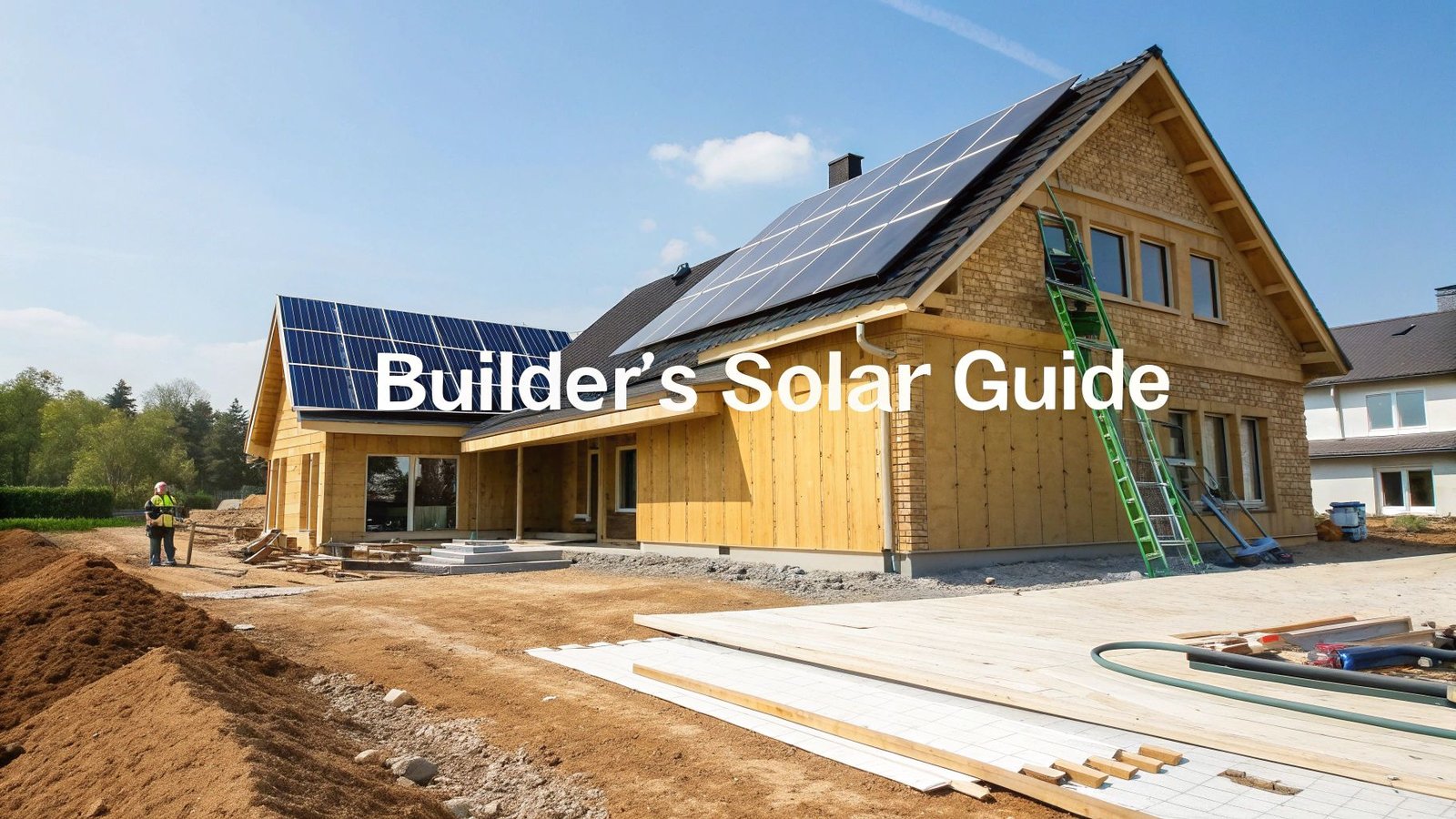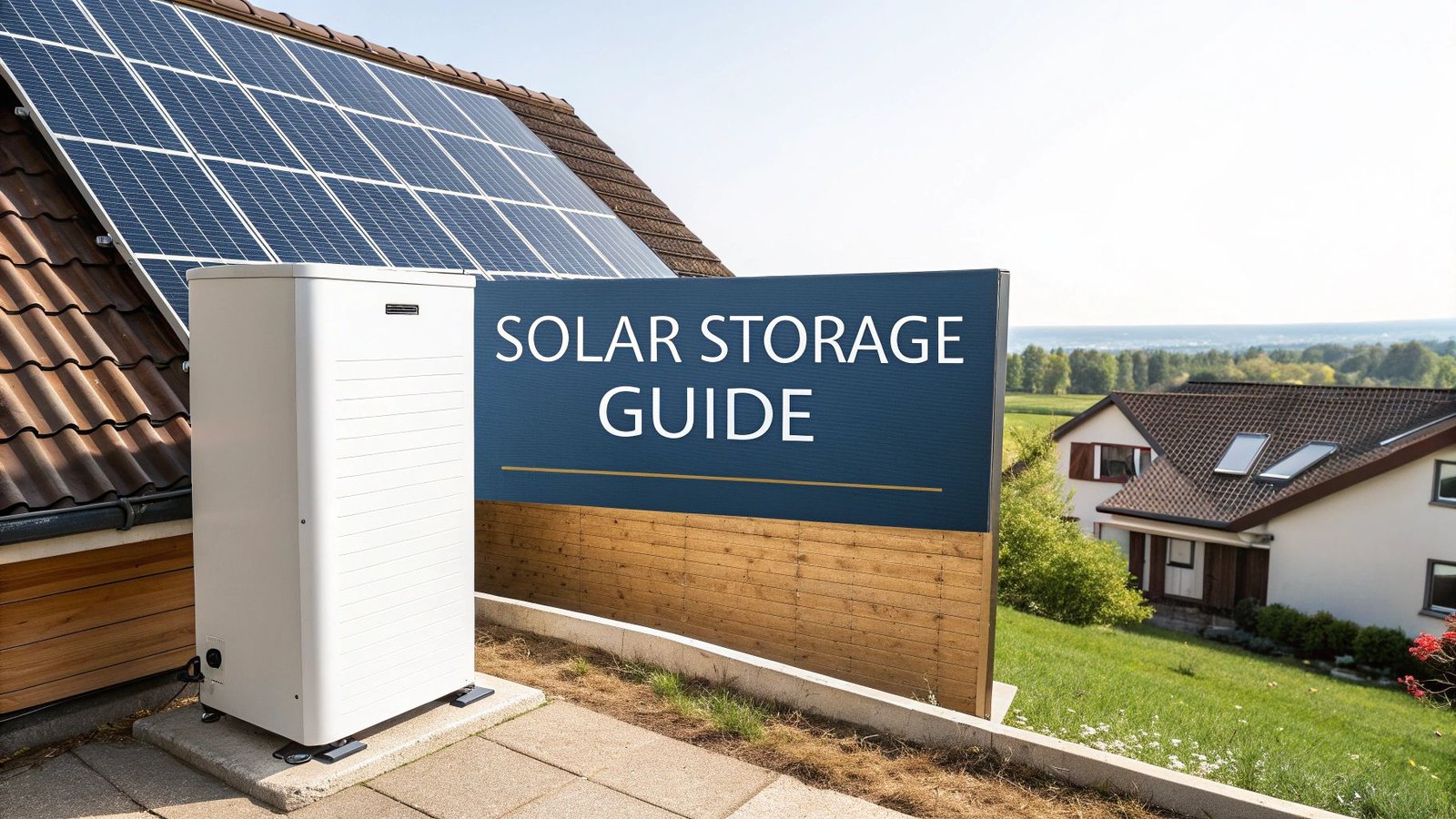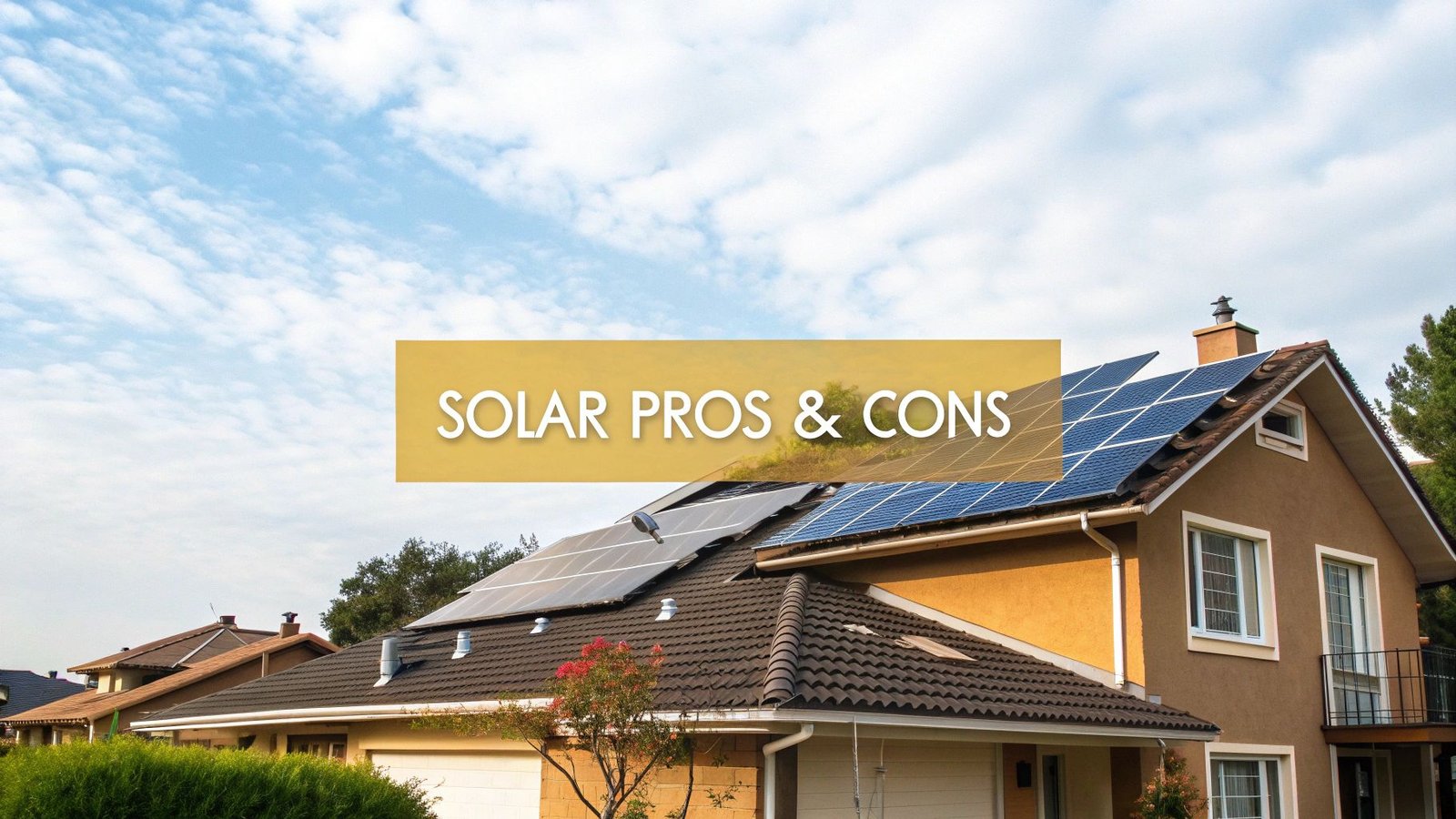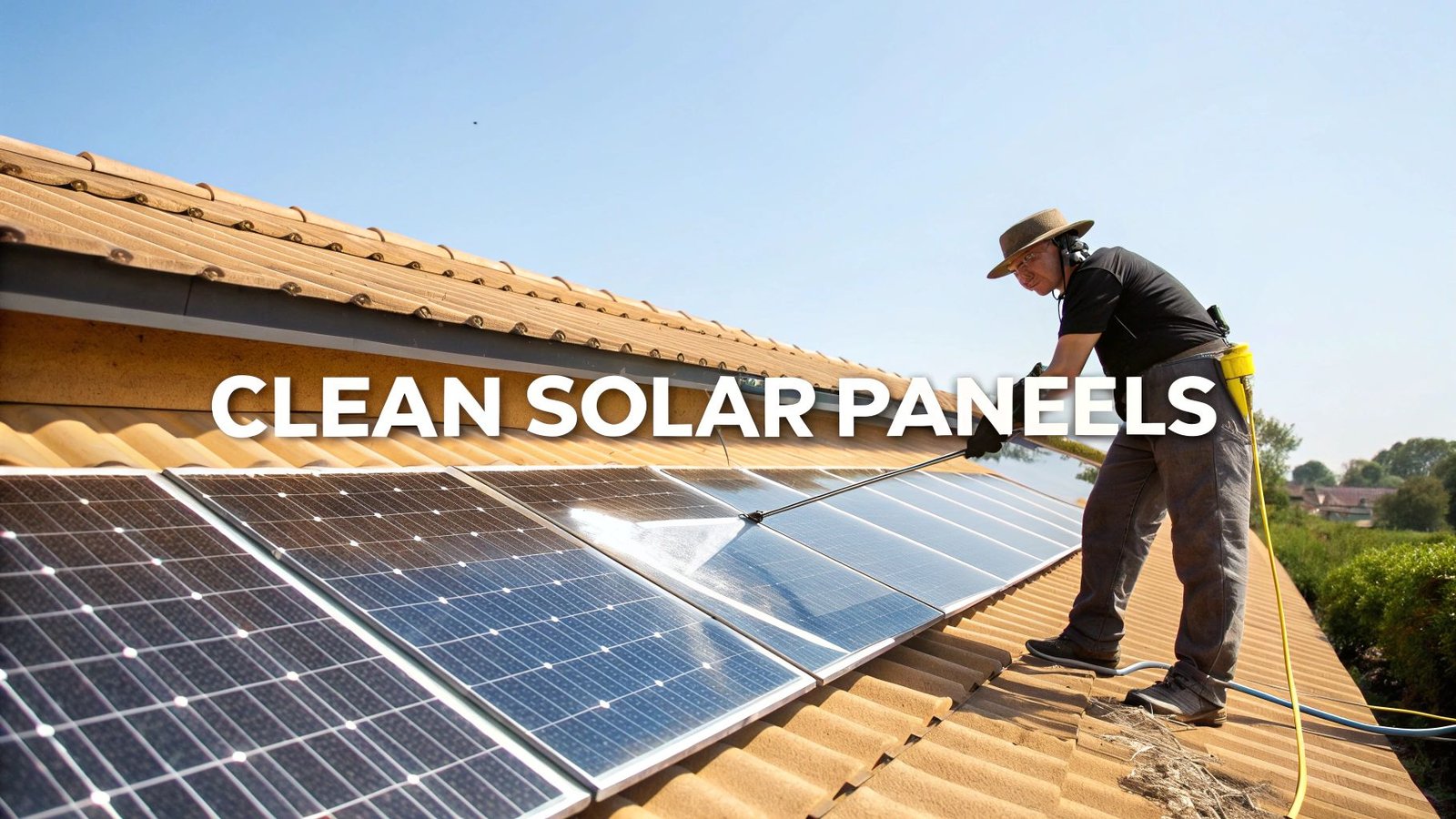Building a new home gives you a golden opportunity to get solar power right from the very beginning. When you plan for solar panels for new construction from the blueprint stage, you can weave the system into the very fabric of your house. This is a massive leap beyond simply slapping panels on a roof later on.
Why Integrating Solar During Construction Is a Game Changer
Sure, adding solar to an existing home is a great move. But designing your new build with solar in mind? That's a whole different level of smart. It treats solar as a core utility, just like your plumbing or electrical systems, not as an add-on. This approach unlocks a kind of seamless efficiency and clean aesthetic that retrofitting just can't match.
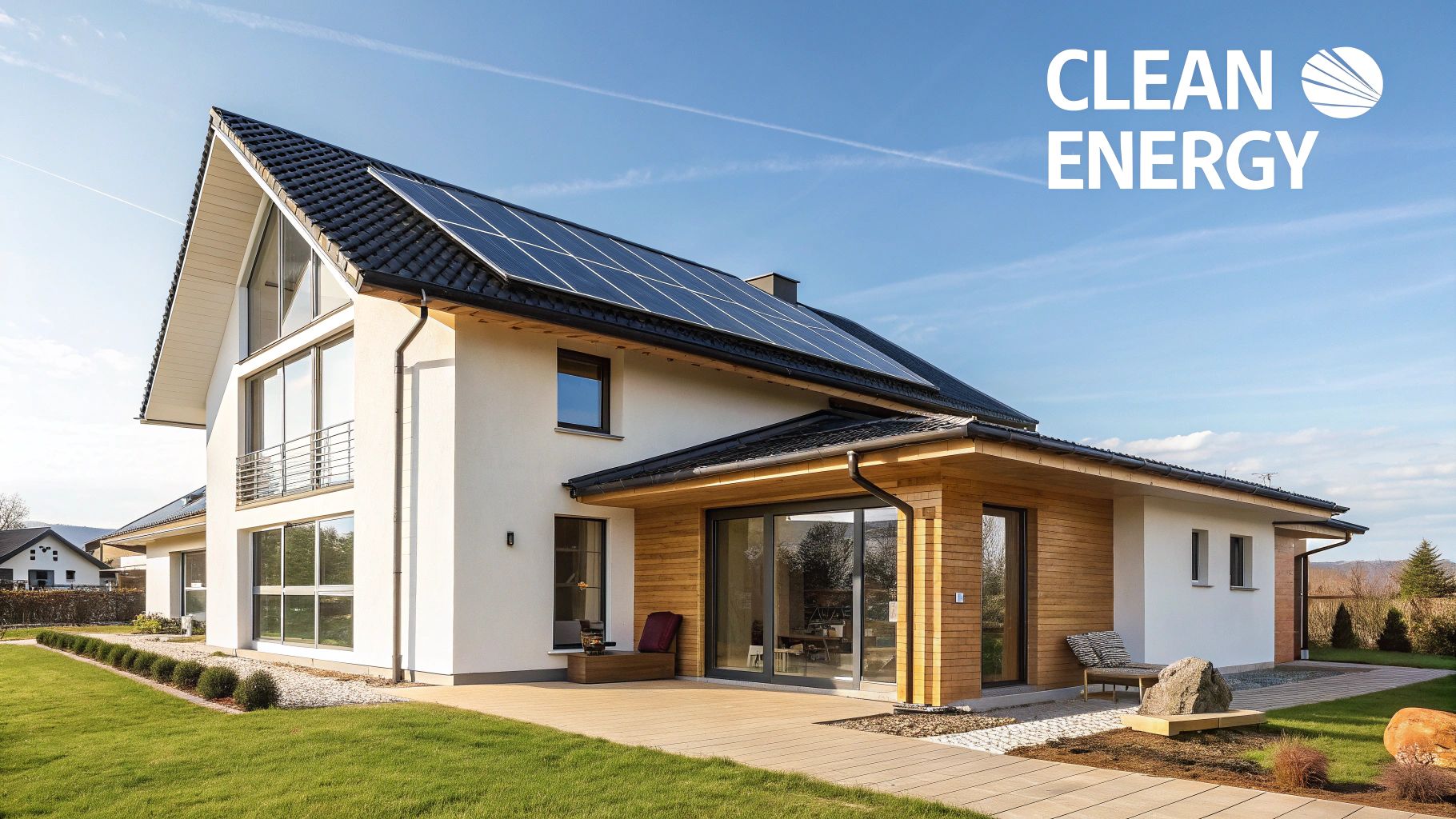
From day one, you, your architect, and your builder are all on the same page. Every decision—from the pitch of the roof to where the electrical panel goes—is made to maximize your solar investment. To get a feel for how all these pieces come together, checking out a comprehensive custom home building process guide can show you exactly where solar planning fits into the bigger picture.
The True Cost of Retrofitting vs Integrating
When homeowners add solar panels after the fact, they often run into headaches and extra costs. Think surprise roof reinforcements, ugly conduit running down the side of the house, or panels awkwardly placed around existing vents. Planning ahead simply makes these problems disappear.
The financial logic is rock-solid, too. Bundling the cost of the solar array into your construction loan is a huge win. Instead of taking out a separate solar loan, which often comes with a higher interest rate, the cost gets absorbed into your home mortgage. In many cases, the slight bump in your monthly mortgage payment is actually less than what you'll be saving on your electric bill.
graph TD
subgraph Retrofit Solar Installation
A[Initial Quote] --> B{Discover Structural Issues};
B --> C[Additional Cost: Roof Reinforcement];
C --> D[Complex Electrical Work];
D --> E[Visible Conduit & Awkward Placement];
E --> F[Higher Total Cost & Longer Timeline];
end
subgraph New Construction Integrated Solar
G[Blueprint Stage Planning] --> H[Engineered Support Included];
H --> I[Pre-wired During Framing];
I --> J[Seamless & Aesthetically Clean];
J --> K[Lower Total Cost & Streamlined Process];
end
style F fill:#f99,stroke:#333,stroke-width:2px
style K fill:#9f9,stroke:#333,stroke-width:2px
By designing with solar from the start, homeowners can save an average of 10-20% on total installation costs compared to a post-construction retrofit. This is due to streamlined labor, reduced structural modifications, and bundled permitting.
Maximizing Long-Term Value and Performance
Getting solar right during the build isn't just about saving a few bucks upfront; it’s about setting yourself up for decades of peak performance and a higher return on your investment. By tailoring the home's design to the solar system, you ensure you're generating as much power as possible from the day you move in.
Just think about the practical advantages:
- Perfect Roof Orientation: Your architect can design the main roof slope to face true south (if you're in the Northern Hemisphere), soaking up the maximum amount of sunlight.
- Built to Handle It: The roof trusses can be engineered from the start to support the exact weight and layout of your solar array. No guesswork, no future structural worries.
- Invisible Wiring: All the electrical conduit can be run inside the walls before the drywall goes up. The result is a clean, professional look with zero exposed hardware.
This kind of forethought leads to a system that’s more powerful, more reliable, and just plain looks better. It’s the difference between a home that’s "solar-ready" and one that is truly solar-optimized—boosting your property value and slashing your energy bills from day one.
Designing Your Home with Solar in Mind
This is where your vision for an energy-efficient home starts to take shape. Integrating solar panels for new construction isn’t just about bolting them on at the end; it’s a conversation you need to have with your architect and builder right from the very beginning.
It’s about making smart, deliberate choices before the foundation is even poured. This isn't guesswork. It's about designing a home that’s optimized for solar energy from the ground up.
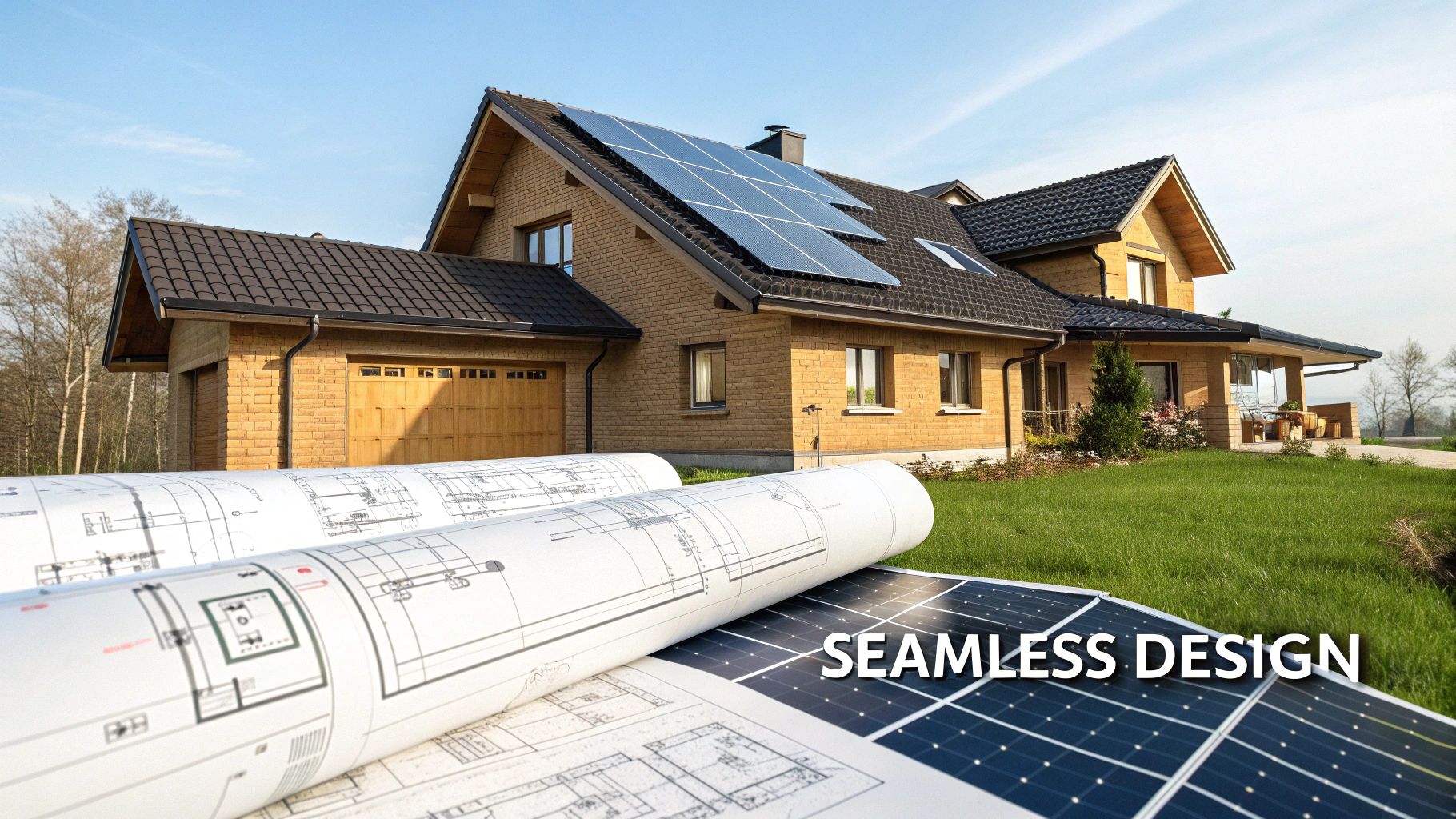
Honestly, these early decisions are what separate a good solar installation from a great one. We’re talking about tackling challenges on paper, where they're easy and cheap to fix, instead of on a half-finished roof, where they become expensive headaches. Think of it as preparing the perfect canvas for your solar array.
Optimizing Your Roof for Maximum Sunlight
Your roof is the most valuable real estate you have for generating power. Its design is everything. The direction it faces and its angle—or pitch—will make or break your system’s performance.
In the Northern Hemisphere, a south-facing roof is the absolute gold standard. It gets the most direct sunlight throughout the day. Your architect can easily design a large, clear roof plane facing south. But don't worry if your lot doesn't allow for a perfect southern exposure. An east-west orientation can work beautifully, too, capturing the morning sun on one side and the afternoon sun on the other.
The real pro-tip here is to match your roof's pitch to your geographic latitude. A pitch somewhere between 30 and 45 degrees is usually the sweet spot for maximizing year-round energy production in most of the U.S.
It’s also crucial to talk about where things like vents, chimneys, and skylights will go. A shadow from a single vent pipe can slash a panel's output. A simple tweak on the blueprint—like grouping all the plumbing vents on the north-facing roof—can prevent these energy-killing obstructions altogether. To get into the weeds on this, you can learn more about the specific solar panel roof requirements that guarantee top performance.
Building a Solar-Ready Structure
Now let’s look under the hood. The structure of your home has to be ready to support a solar array for decades. This is another one of those conversations with your builder and engineer that pays off massively down the road.
Here are the key structural points to bring up:
- Engineered Trusses: Make sure your roof trusses are engineered from the start to handle the extra weight. Solar panels add about 2-4 pounds per square foot, which is easy to account for in the initial design but a pain to reinforce later.
- Roofing Material Choice: Go for durable materials. Things like quality asphalt shingles, standing-seam metal, or tile have a lifespan of 25+ years. This lines up perfectly with the warranty on most solar panels, meaning you won’t have to tear everything off for a roof replacement.
- Clear Roof Space: A simple, clean roof design is your best friend. A straightforward gable roof provides a much better canvas for solar panels than a complex hip roof with tons of small sections and dormers. It allows for a cleaner look and a more efficient layout.
Getting this right means your home isn't just "solar-ready"—it's truly "solar-optimized."
Pre-Wiring for a Seamless Installation
One of the biggest wins of planning for solar during a new build is the ability to hide all the wiring. Running the electrical conduit before the drywall goes up gives you an incredibly clean finish that’s just not possible with a retrofit.
Your builder and solar installer can coordinate to run conduit from the attic right down to where your main electrical panel and inverter will be. It's a small step that makes a huge difference. No ugly exterior conduit, lower labor costs for the final install, and a much simpler process overall.
While you're at it, think about the future. Even if you aren't getting a battery or an EV charger right away, running the extra conduit to the garage or utility room is dirt cheap during construction. This kind of foresight turns future upgrades into a simple plug-and-play job, saving you thousands in labor and drywall repairs later on.
Navigating Permits and Financial Incentives
Once your solar design is locked in, it's time to tackle the money and the paperwork. This part of the process can seem daunting, but it's where a smart energy decision transforms into an outstanding financial investment for your new home.
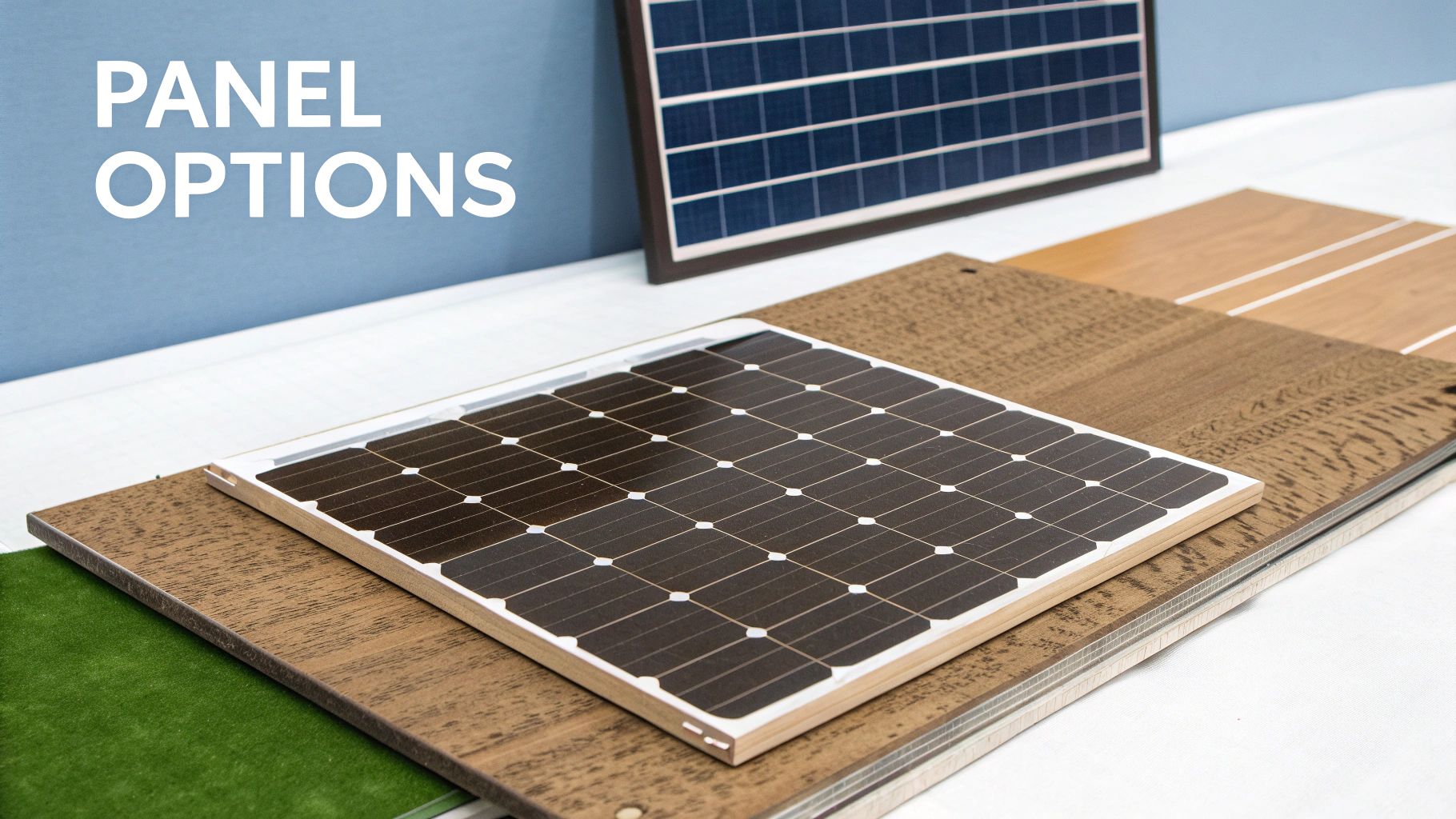
Think of this phase less as a hurdle and more as a strategy. You’re not just getting approvals; you're actively working to bring down the net cost of your system. A great builder or solar installer will be your guide here, but knowing the landscape yourself gives you a huge advantage.
Making Permitting a Breeze
Before any work begins, you need the green light from your local government. The good news? Getting a permit for solar on a new build is almost always easier than adding it to an existing home. Why? Because the solar plans can be bundled right in with all the other construction permits.
Your builder will typically handle the submission, which includes key documents like:
- Structural Plans: These confirm the roof is engineered to handle the weight of the solar array.
- Electrical Schematics: Think of this as the electrical roadmap, showing how the panels, inverter, and wiring will safely connect to your home and the grid.
- Equipment Specs: Datasheets for the specific panels and inverters you’ve chosen.
The whole point is to prove the system is safe and up to code. If you want to get into the nitty-gritty, our guide on solar panel permit requirements breaks it all down.
Unlocking Serious Savings with Financial Incentives
Here’s where it gets really good. A powerful mix of federal, state, and local incentives can slash the cost of your solar installation.
Regulations are increasingly pushing for solar on new homes, and it's making a massive difference. California's Title 24 code, for example, now requires most new homes to have solar. Policies like this have helped the U.S. blow past 160 GW of total installed solar capacity, with over 4.7 million American homes now powered by the sun.
The single most valuable incentive for most people is the federal Residential Clean Energy Credit, also known as the Investment Tax Credit (ITC).
Key Takeaway: The federal ITC allows you to claim a tax credit worth 30% of the total cost of your solar system. This isn't just a deduction—it’s a dollar-for-dollar reduction of the federal income tax you owe.
Let’s put that in perspective. For a $25,000 solar system, the ITC gives you a $7,500 tax credit, instantly dropping your net cost to $17,500. When you’ve rolled the cost of the solar into your mortgage, that credit feels like a huge cash rebate.
pie
title Solar System Cost Breakdown ($25,000 System)
"Net Cost after ITC" : 17500
"Federal ITC (30%)" : 7500
But the federal credit is just the beginning. Savvy homeowners can stack multiple incentives to maximize their savings.
This table gives you a snapshot of what's out there.
Key Solar Incentives for New Construction
| Incentive Type | What It Covers | Potential Value | How to Apply |
|---|---|---|---|
| Federal Tax Credit (ITC) | A percentage of the total system cost, including equipment and labor. | 30% of Total Cost | Through your annual federal tax return using IRS Form 5695. |
| State Rebates | Cash-back incentives from state energy programs for installing renewable energy. | Varies by state; can be a few thousand dollars. | Check your state's Department of Energy or equivalent agency website. |
| Utility Grants | Financial incentives offered directly by your local electric utility company. | Ranges from a few hundred to several thousand dollars. | Look for renewable energy programs on your utility's official website. |
| SRECs | Solar Renewable Energy Credits that you can earn and sell in certain markets. | Value fluctuates based on market supply and demand. | Register your system with a state-approved SREC aggregator or marketplace. |
When you start layering these programs, it's not uncommon for homeowners to reduce their total installation cost by 40-50% or even more. This powerful financial support is what makes adding solar during construction an undeniable win for your wallet.
Choosing the Right Solar Technology for Your Build
Picking the right hardware for your home's solar system isn't just a technical detail—it's a long-term decision that will define your energy performance for decades to come. When you're installing solar panels for new construction, you get a unique opportunity. You can select the perfect tech to match your home's look, budget, and energy goals without making any compromises down the road.
The global push for renewables has made this technology more available and powerful than ever. In the first half of 2025 alone, a staggering 380 gigawatts (GW) of new solar capacity was installed worldwide. That's a 64% jump from the 232 GW added during the same period in 2024, cementing solar's place as the fastest-growing source of new electricity.
Panel Types: A Balancing Act of Efficiency and Aesthetics
The most visible part of your system is the panels themselves, and you've got options. The two main contenders in the residential space are monocrystalline and polycrystalline panels, and they each have their place.
- Monocrystalline Panels: These are the sleek, black panels you often see in modern installations. Made from a single, pure silicon crystal, they are the most efficient option on the market. This high efficiency means you need fewer panels to hit your power goals, making them perfect for smaller roofs or for homeowners who want a clean, minimalist aesthetic.
- Polycrystalline Panels: Easily identified by their blue, marbled appearance, these panels are made from multiple silicon fragments melted together. While they are a bit less efficient than their monocrystalline cousins, they're also easier on the wallet. If you have a large, unobstructed roof, they can be a fantastic, cost-effective way to power your home.
If you're looking for a deeper dive into the pros and cons, our guide on how to choose solar panels breaks down the specifics even further.
Comparing Solar Tech for Your New Home
Choosing between different solar technologies can feel overwhelming. This table offers a side-by-side look at the most common options to help you figure out the best fit for your new home's performance needs and curb appeal.
| Technology Type | Key Benefit | Ideal Scenario | Cost Profile |
|---|---|---|---|
| Monocrystalline Panels | Highest efficiency and sleek, uniform look | Homes with limited roof space or a modern design aesthetic | Premium |
| Polycrystalline Panels | More budget-friendly initial investment | Large, south-facing roofs without shading issues | Value |
| String Inverters | Cost-effective and reliable for simple systems | A simple roof plane with consistent sun exposure | Standard |
| Microinverters | Maximizes energy production per-panel | Complex roofs with multiple angles, dormers, or partial shading | Higher |
| Battery Storage | Energy independence and backup power | Homeowners wanting to avoid grid outages and peak-time rates | Add-on Investment |
Ultimately, the right combination of tech will depend on your specific roof, budget, and how you plan to use your energy.
Inverters: The Brains of Your Solar Operation
If the panels are the heart of your system, the inverter is the brain. This is the device that takes the direct current (DC) electricity your panels produce and converts it into the alternating current (AC) your home's appliances actually run on. The design of your roof is the single biggest factor in choosing the right one.
A string inverter is a great, cost-effective option for a simple, south-facing roof with no shade. However, if your roof has multiple angles, dormers, or potential shading from trees, microinverters are the superior choice, as they optimize the performance of each individual panel.
With microinverters, a little shade on one panel won't cripple the output of the entire system. That kind of flexibility is a massive advantage for more complex rooflines, ensuring you squeeze every possible watt out of your investment.
Should You Add a Battery Storage System?
The final piece of the tech puzzle is energy storage. A home battery, like a Tesla Powerwall, lets you bank the excess solar energy your panels generate during the day. You can then use that stored power at night, during a storm, or anytime the grid goes down. It’s the key to achieving true energy independence.
There's no better time to install a battery than during new construction. All the wiring can be routed cleanly inside the walls before the drywall goes up, and the system can be perfectly sized for your home's expected energy load. While it does add to the upfront cost, a battery future-proofs your home, shields you from grid instability, and helps you sidestep the expensive peak electricity rates charged by your utility.
As you explore solar, it's also a great time to look at other energy-efficient tech solutions that can work together to lower your home's overall consumption.
The image below really drives home the difference between integrating solar during the build versus adding it later.
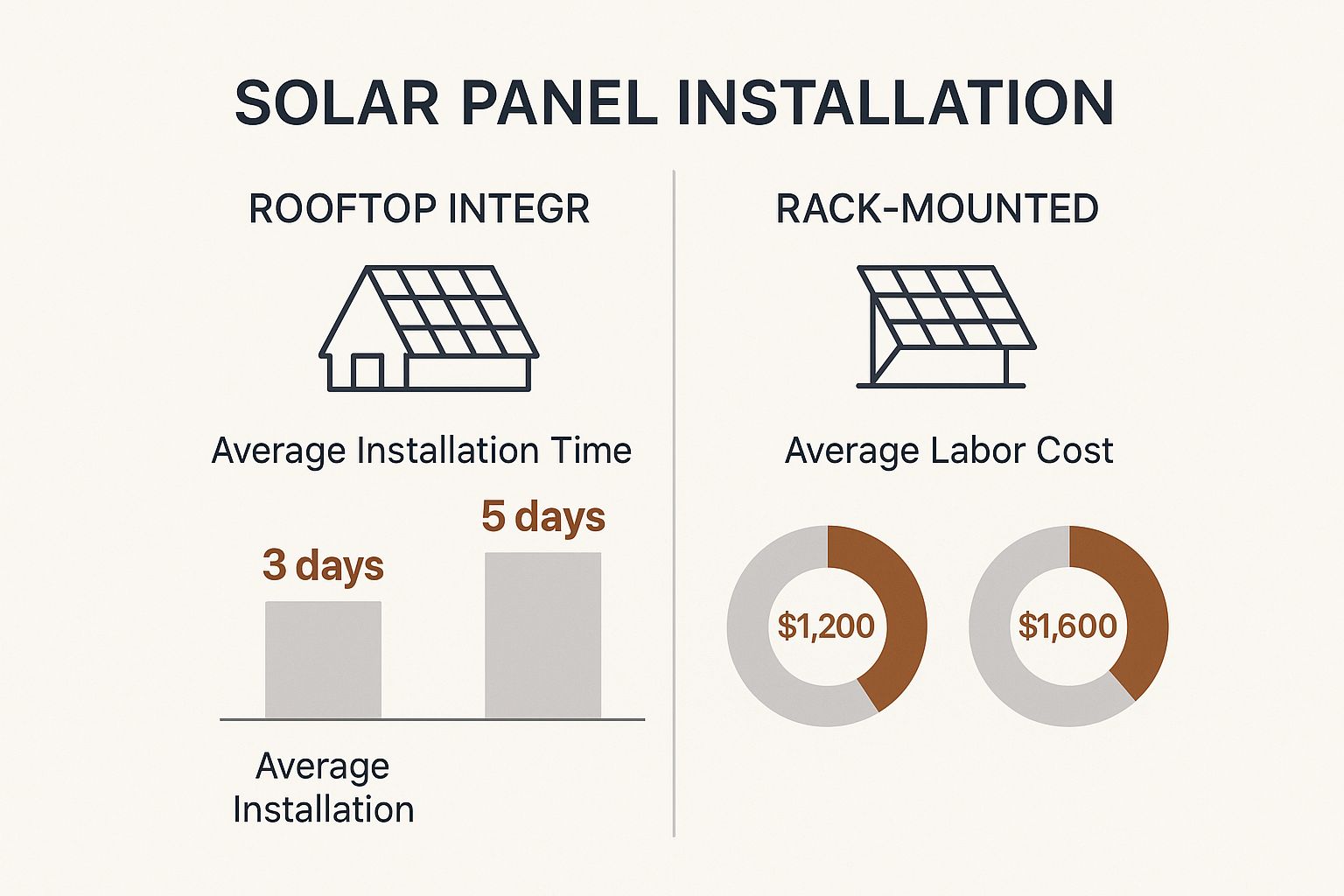
As you can see, planning for solar from the beginning drastically cuts down on both installation time and labor costs. It’s one of the clearest financial arguments for making solar part of your initial architectural plans.
The Future of Solar in Home Construction
When you decide to build solar into your new home, you're doing a lot more than just saving a few bucks on your power bill. You're plugging your home into a massive global movement. It's a worldwide shift toward smarter, more sustainable living, and seeing that bigger picture really puts the long-term value of your investment into perspective. This isn't just about an energy-efficient house; it’s about building a future-proof asset.
This whole movement is being supercharged by incredible leaps in manufacturing and scale. As more countries get serious about renewable energy, the demand for solar has exploded. That boom has sparked a ton of innovation and, best of all, brought costs way down for homeowners.
Global Manufacturing and What It Means for You
One of the biggest reasons high-efficiency solar panels for new construction are more affordable than ever is the sheer scale of international manufacturing. Production volumes are through the roof, creating a fiercely competitive market that has pushed prices down while cranking performance up. What used to be a niche, high-end technology is quickly becoming a standard feature in modern homes.
Just look at how dramatically the cost of solar modules has fallen over the last decade. This trend is a direct result of that global production boom.
xychart-beta
title "Average Cost of Solar PV Modules ($/Watt)"
x-axis [2014, 2016, 2018, 2020, 2022, 2024]
y-axis "Cost per Watt ($)" [0, 0.2, 0.4, 0.6, 0.8]
bar [0.72, 0.55, 0.35, 0.24, 0.28, 0.22]
Data Source: NREL Annual Technology Baseline
This downward price trend makes the numbers for solar on a new build look incredibly good. The panels you install today are not only more powerful but also significantly cheaper than they were just a few years ago. That translates to a faster payback period and a much better return on your investment.
A Peek at the Global Solar Leader
China, in particular, has become the undisputed giant in the global solar panel market, and that has a huge ripple effect on technology and prices everywhere. By the end of 2024, China's total installed solar capacity shot past 1 terawatt (TW)—that's nearly half of the entire world's total. This insane scale has created an oversupply of solar modules, pushing prices even lower and making solar a no-brainer for new construction projects worldwide. If you're a data nerd, you can dig into the specifics of these global photovoltaic market dynamics.
Understanding this global context is key. It means your investment is backed by a mature, stable, and still-growing industry.
Your solar-powered home isn't just a building; it's a resilient asset perfectly aligned with where energy is headed. As utility rates keep climbing and grid reliability becomes a bigger question mark, a home that generates its own power becomes incredibly valuable.
Taking this proactive approach to energy ensures your home stays relevant, marketable, and cheap to run for decades. By building with solar from day one, you’re not just hopping on a trend—you’re putting your home at the forefront of a permanent shift in how we live. You're securing a smarter, more sustainable future.
Common Questions About New Build Solar
https://www.youtube.com/embed/OTj_R-c1KiY
Even with the best plans in hand, you're bound to have some questions as you get closer to integrating solar into your new home. It’s a big decision. Here, I'll tackle the most common questions we get from homeowners, giving you straight, practical answers to help you lock in those final details.
Can I Roll the Cost of Solar Panels Into My Mortgage?
Absolutely, and honestly, this is one of the biggest financial wins of going solar on a new build.
Most lenders are perfectly happy to let you wrap the entire cost of the solar system right into your construction loan. That loan then converts into your long-term home mortgage. What this does is let you avoid taking out a separate, often higher-interest loan just for the solar equipment.
By spreading the cost over the 15 or 30-year term of your mortgage, the bump in your monthly payment is usually pretty small. In many cases, we see homeowners saving more on their electricity bill each month than the increase in their mortgage payment. You start with positive cash flow from day one.
The key is to bring this up with your lender early. That gives them time to ensure the home's final appraisal properly accounts for the added value of the solar installation, which makes the whole financing process go smoothly.
How Much Value Do Solar Panels Add to a New Home?
The numbers don't lie: homes with solar panels sell for more. A landmark study found that, on average, homes with solar sold for 4.1% more than similar homes without it. For a new build, that value is baked in from the very beginning.
Think about it this way: a solar energy system isn't just a cosmetic upgrade like fancy countertops. It delivers a real, measurable financial return through years of lower energy bills. When the system is integrated from the blueprint stage, buyers and appraisers see it as a premium, forward-thinking feature, not just an add-on. This immediately boosts your home’s marketability and its appraisal value.
Is a Battery System Worth It on a New Build?
While you might not be required to have a battery, it’s an incredibly smart move and is quickly becoming the standard for new solar homes. A battery gives you true energy independence. You can store the extra solar power your panels generate during the day and use it at night or, more importantly, during a power outage.
A battery also lets you play the utility game. You can use your stored energy during peak hours when grid electricity is most expensive, saving you even more money. The best part? Integrating a battery during construction is so much easier and cleaner. All the wiring is tucked away behind the walls before the drywall even goes up.
By 2030, U.S. electricity demand is projected to grow by 7%, thanks to new data centers, manufacturing, and housing. This is putting more and more strain on the grid, making a battery an invaluable asset for backup power and energy security.
Adding a battery essentially future-proofs your home against an unstable grid and rising rates, making sure you get every last drop of value from your solar investment.
What Happens if My Roof Needs Repairs in the Future?
This is a totally valid concern, but it’s far less of an issue when you’re planning for solar from the start. You’re beginning with a brand-new roof that’s designed to last 20-30 years. That lifespan lines up almost perfectly with the warranty and expected life of your solar panels.
When a professional integrates the installation during new construction, every roof penetration for the mounts is meticulously flashed and sealed, which dramatically reduces the risk of leaks down the road.
In the rare event a repair is needed decades from now, a certified solar installer can simply remove the affected panels and reinstall them once the work is done. Yes, there's a service cost for that, but it's not a common occurrence. The financial benefit from decades of tiny-to-nonexistent electricity bills will far outweigh this small, potential expense. When planned together, your roof and solar system become a single, long-lasting unit.
Ready to build a smarter, more efficient home from the ground up? At Radiant Energy, we specialize in designing and installing high-performance solar solutions for new construction projects. Let us help you integrate clean energy seamlessly into your new build. Explore our solar installation services today.

